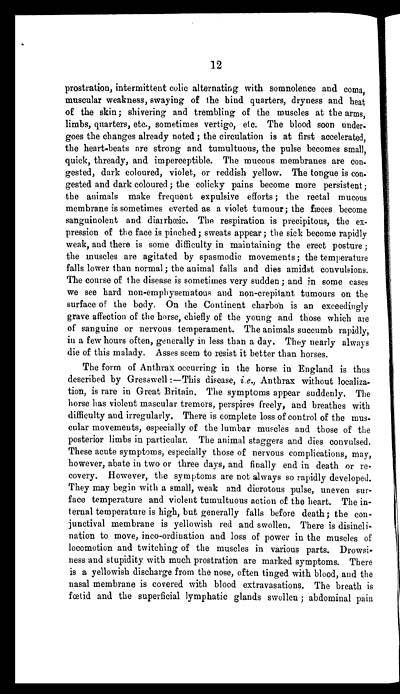Medicine - Veterinary > Civil Veterinary Departments > Civil Veterinary Department ledger series I-VI > Volume II - Anthrax
(118) Page 12
Download files
Individual page:
Thumbnail gallery: Grid view | List view

12
prostration, intermittent colic alternating with somnolence and coma,
muscular weakness, swaying of the hind quarters, dryness and heat
of the skin; shivering and trembling of the muscles at the arms,
limbs, quarters, etc., sometimes vertigo, etc. The blood soon under-
goes the changes already noted; the circulation is at first accelerated,
the heart-beats are strong and tumultuous, the pulse becomes small,
quick, thready, and imperceptible. The mucous membranes are con.
gested, dark coloured, violet, or reddish yellow. The tongue is con-
gested and dark coloured; the colicky pains become more persistent;
the animals make frequent expulsive efforts; the rectal mucous
membrane is sometimes everted as a violet tumour; the fæces become
sanguinolent and diarrhœic. The respiration is precipitous, the ex-
pression of the face is pinched; sweats appear; the sick become rapidly
weak, and there is some difficulty in maintaining the erect posture;
the muscles are agitated by spasmodic movements; the temperature
falls lower than normal; the animal falls and dies amidst convulsions.
The course of the disease is sometimes very sudden; and in some cases
we see hard non-emphysematous and non-crepitant tumours on the
surface of the body. On the Continent charbon is an exceedingly
grave affection of the horse, chiefly of the young and those which are
of sanguine or nervous temperament. The animals succumb rapidly,
in a few hours often, generally in less than a day. They nearly always
die of this malady. Asses seem to resist it better than horses.
The form of Anthrax occurring in the horse in England is thus
described by Gresswell:—This disease, i.e., Anthrax without localiza-
tion, is rare in Great Britain. The symptoms appear suddenly. The
horse has violent mascular tremors, perspires freely, and breathes with
difficulty and irregularly. There is complete loss of control of the mus-
cular movements, especially of the lumbar muscles and those of the
posterior limbs in particular. The animal staggers and dies convulsed.
These acute symptoms, especially those of nervous complications, may,
however, abate in two or three days, and finally end in death or re-
covery. However, the symptoms are not always so rapidly developed.
They may begin with a small, weak and dierotous pulse, uneven sur-
face temperature and violent tumultuous action of the heart. The in-
ternal temperature is high, but generally falls before death; the con-
junctival membrane is yellowish red and swollen. There is disincli-
nation to move, inco-ordination and loss of power in the muscles of
locomotion and twitching of the muscles in various parts. Drowsi-
ness and stupidity with much prostration are marked symptoms. There
is a yellowish discharge from the nose, often tinged with blood, and the
nasal membrane is covered with blood extravasations. The breath is
fœtid and the superficial lymphatic glands swollen; abdominal pain
Set display mode to: Large image | Zoom image | Transcription
Images and transcriptions on this page, including medium image downloads, may be used under the Creative Commons Attribution 4.0 International Licence unless otherwise stated. ![]()
| India Papers > Medicine - Veterinary > Civil Veterinary Departments > Civil Veterinary Department ledger series I-VI > Anthrax > (118) Page 12 |
|---|
| Permanent URL | https://digital.nls.uk/75516126 |
|---|




